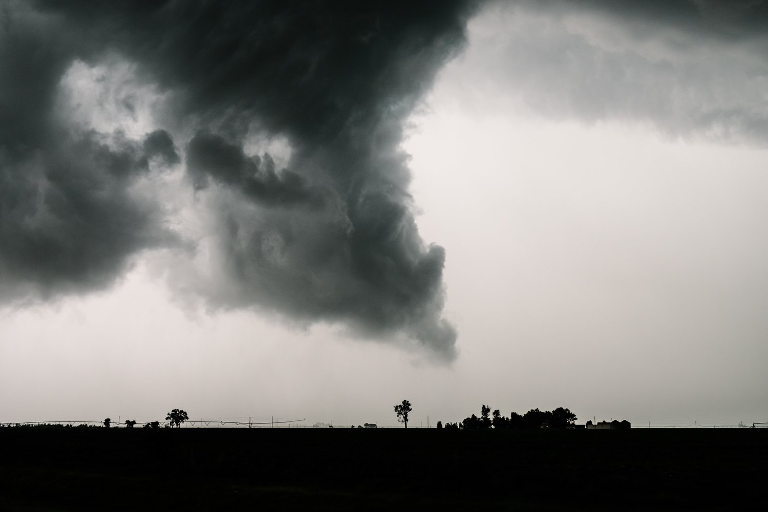On November 17th, video emerged depicting someone sitting alone on London’s Waterloo Bridge, in the middle of the road. A line of vehicles—including two red double-decker buses—drove directly at the individual, who sat unmoving, staring straight ahead. The scene evoked the iconic image of the “Tank Man”—the lone, unidentified man who stood before a tank column in Tiananmen Square after the military had forcibly shut down protests.
But unlike Tank Man, the person on the bridge was not alone. Very soon, another joined and sat. Then a few more. Soon, dozens were flooding the road and blocking the bridge. This marked the start of Rebellion Day, an event launched by Extinction Rebellion, or “XR,” a new movement dedicated to halting climate collapse. The event turned out to be one of the largest acts of civil disobedience in the UK in decades. The group blocked off five central London bridges with 6,000 participants, of whom nearly 100 were arrested. The two double-decker buses stopped cold and did not move again for the rest of the protest. Walking on the bridge full of drums beating and people dancing under a bright sun—cold vehicles sitting vacant—felt like a surreal glimpse of what a positive post-carbon world could look like. On April 15th, XR launched their “International Rebellion,” a campaign to spread its movement across the world. Nearly a thousand activists were arrested during the eight-day action. As with the Rebellion Day, it offered a glimpse of a post-carbon world: in shutting down four main London sites, the protest measurably reduced air pollution.
This represents a vital turning point in the global climate movement. But it doesn’t go nearly far enough. The movement to pass Green New Deal-style legislation commensurate with the challenge of climate change will have to be much more disruptive than blocking bridges. While the demonstrations by XR and other climate activists in the US have seen much success in getting people talking about climate change and have helped to shift momentum in the right direction, even these protests do not reflect the imminent reality of civilizational collapse and mass devastation to life on earth.
How might climate emergency activists build a more confrontational, revolutionary movement? There are many examples from history, but one contemporary example could offer at least a few lessons: the Yellow Vest movement in France. While it’s not necessary that all climate activism incorporate these confrontational tactics, some kind of radical flank will likely be necessary to push legislation in a more ambitious direction.
First, it’s important to note that Extinction Rebellion is a very desirable step forward from the tepid activism of the past. XR now has hundreds of thousands of supporters spread across dozens of chapters. They’ve already held dozens of direct actions across Britain with hundreds of arrests. They now have organizers on at least four continents and are rapidly expanding their civil disobedience campaigns globally. These activists are serious and sophisticated. The group Rising Up, which started XR, has extensive experience; one of its main organizers, Roger Hallam—whom the Financial Times described as “Gandalf-like”—is a doctoral researcher focusing on radical campaign design. I met Hallam and other activists at XR’s Rebellion Day. They spoke with a fluency in social science and an urgency rooted in climate science that I’ve rarely heard in the climate movement. As philosopher and politician Rupert Read, who spoke at the event, told me: this is our “last chance” to avert the death of billions. George Monbiot, another prominent XR activist, recently wrote about the need to overthrow capitalism.
Perhaps most crucially, this new movement presents a stark moral clarity absent in the past. This isn’t about humans fighting an amoral climate system. This represents a conflict between people who believe in life, justice, and the sanctity of future generations against those people who don’t. This is one of those rare life-versus-death, good-versus-evil conflicts. The movement has drawn a line in the ashes and declared: it’s time to pick a side. After all, the moral rightness of clogging infrastructure is clear and simple: would it have been the ethical thing to do to halt the Titanic to avoid hitting an iceberg, even if the passengers’ commute was temporarily stalled? Those who say “forge ahead, ram the iceberg,” even while knowing the consequences, are evil and must be stopped.
Beyond tactics and ethics, the climate movement’s goals have shifted as well. The Green New Deal, the policy vision US climate action is now rallying around, presents a fundamental shift in what the movement is trying to achieve. In order for a GND to be commensurate with the science of climate change, it must seek to entirely dismantle the economy’s reliance on fossil fuels while building a fairer means of organizing life; or as Monbiot succinctly put it, “overthrow capitalism.” With huge pluralities of Americans supporting a rapid shift away from fossil fuels and toward 100% renewables, and with solving economic woes at the top of most Americans’ political agenda, there’s good reason to believe the GND policy vision will find purchase among a broader coalition of supporters.
But passing such revolutionary policies will not be easy and must not be underestimated. As with the FDR-era New Deal, achieving this monumental change will require mobilizing millions of people working together on the ground. In the lead up to the New Deal, thousands of annual strikes and millions of workers came together to agitate for radical change. Given the scale of change necessary to fundamentally reshape the economy, we need an even greater degree of disruptive action to pass GND policies.
While new climate emergency groups like XR have taken a vital step toward a more reality-based movement, they have not gone far enough. What we need to see in the US and abroad is a movement that adopts a more confrontational, disruptive coalition focused on overthrowing not just the neoliberal paradigm in which climate change has accelerated and positive action has been stifled, but the roots of capitalism itself. The Yellow Vest (YV) movement in France could offer some lessons for climate activists.
As it happens, the YV movement began demonstrations all over France on the same day that XR launched their Rebellion Day in London. The YV demonstrations, too, involved blocking roads. But their paths have since diverged sharply, with differences between the movements growing stark. Whereas YV is fundamentally a populist, working-class movement focused on economic justice, XR has less substantial messages about economic justice, except incidental and sometimes peripheral nods to resisting corporations. They recently got into some trouble with leftists for showing affection for the police and declaring themselves “beyond politics.” While YV is a long-overdue response to neoliberal politics represented by French President Macron and global consolidation of wealth, XR is speaking more to the decades of liberal inaction on climate. Compared with YV’s rioting, mass strikes, fistbrawls with police (protesters are literally losing their limbs to police violence), XR’s street parades seem quite tame.
Part of this is intentional; XR organizers have sought to do everything properly, like getting permission before marching and closing streets, while being open and friendly with police and bystanders. There are good reasons to be approachable and welcoming if the goal is to make climate concern more mainstream or to impact the national conversation. But to pass GND-style policy, and to fundamentally erode capitalism, we need to do so much more than try to bring attention to climate change. And so far this strategy has failed to provoke fear or respect in the people activists are supposed to be rebelling against. It’s easy for MPs to laugh off a happy hippie gathering; it was easy for passersby to ignore the protesters and I heard more than one say something to the effect of “they need to get a job,” and other equally dismissive suggestions. That’s a problem. It’s hard to have our issues taken seriously if our movement is not. It’s hard to get people to believe the world is ending when we’re not acting like it. One of XR’s own slogans admonishes, “Tell the truth and act like it’s real.” Perhaps “acting like it’s real” means going further than XR yet has.
There are of course replicability issues with bringing a YV-style movement to the US and UK climate movements. The Anglophone world has generally been more timid than the French in standing up to elites. Liberté, égalité, fraternité is not so deeply embedded in US and UK political cultures. But marrying the economic populism of YV with the emergency climate stance of XR need not be far-fetched. As Emily Atkin has pointed out, the Yellow Vests themselves are in favor of radical action on climate change. “In a communique issued on November 23, the Yellow Vests said France should ‘put in place a real ecological policy and not a few piecemeal fiscal measures.’” They want climate policy to be commensurate with the problem, but also just. Macron and other elites will continue trying to put the burden of decarbonization on the working-class and middle-class; like YV, climate activists must be insisting that elites pay for most of it.
While the path to building a truly revolutionary, populist climate movement may look quite different from the Yellow Vests, there can be no doubt that such confrontational action will be necessary if policy like a GND is to get any traction. This is particularly true battling governments largely beholden to fossil fuel interests and consolidated wealth. Street parades and congressional sit-ins will only take us so far. At some point, we will need general labor strikes, we will need tight, militant organizational discipline, and we will need more diverse support. The broad support for a GND may point to a real possibility of building something like this.
There were many beautiful moments on the London bridges in XR’s opening protests. Seeing one group of cheering activists join another with hugs and smiles was truly awe- and hope-inspiring. Many moving speeches were given, a haunting call to prayer sung. But while many first-time activists have joined XR, it’s still far from the revolutionary movement that we will need for revolutionary policy. One of the protesters called out to the crowd gathered on Waterloo Bridge, “If you’ve ever wondered what you would have done during the Second World War, this is your answer.” Fighting evil in the 1940s was not a peaceful, niche enterprise. Doing so today must not be either.






